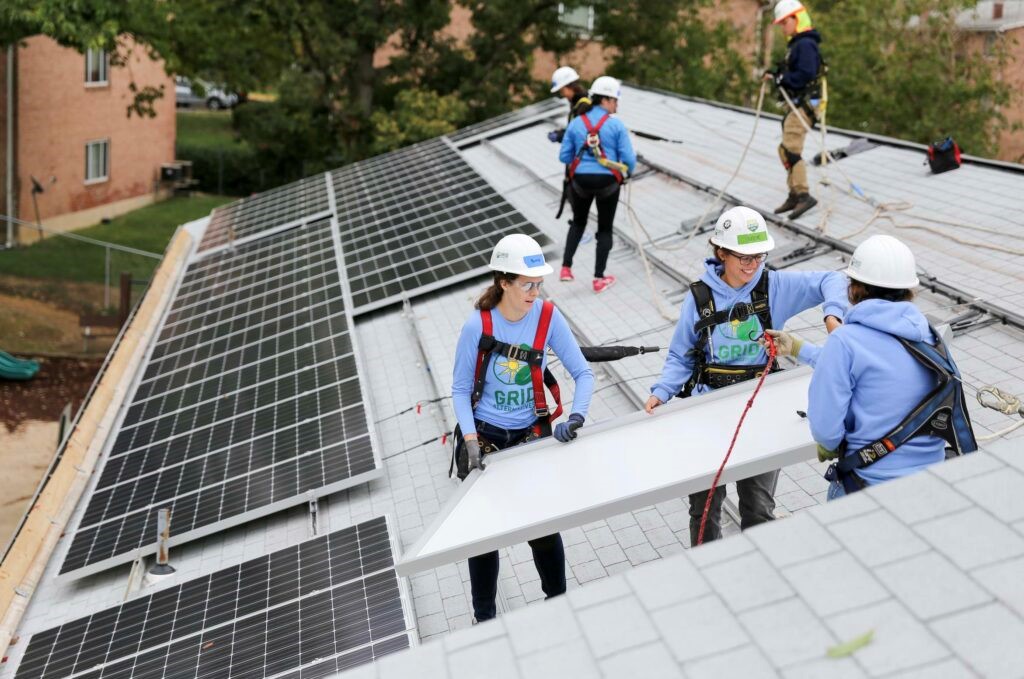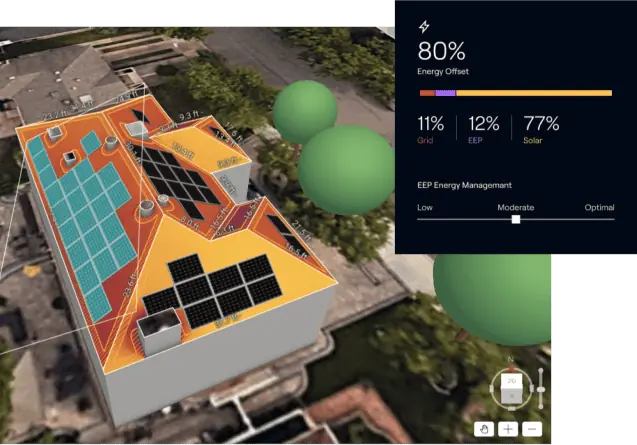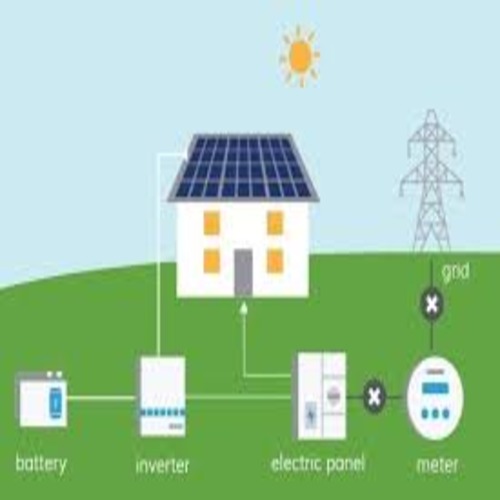Solar power backup system
Solar power backup system can power an incredible range of applications — from a remote cabin to keeping the lights on in the International Space Station. But we all know solar isn’t just for providing remote power needs.
There’re virtually unlimited reasons why people choose to go solar. From energy independence, to reducing energy bills, to climate concerns, there’s really no “wrong” reason to install panels. And as solar panels continue to drop in price, they’ve become a competitive energy option for more and more homes and businesses.
Solar panels, also known as photovoltaic (PV) panels, are devices designed to capture sunlight and convert it into electricity. They are composed of numerous solar cells made from semiconductor materials, typically silicon. When sunlight strikes these cells, it stimulates the movement of electrons, generating direct current (DC) electricity.
How do solar panels work?
Solar panels work by harnessing the energy from sunlight and converting it into usable electricity through a process called the photovoltaic effect. Here’s a breakdown of how solar panels work:
- Absorption of Sunlight: Solar panels are made up of solar cells, which are typically made of silicon. When sunlight hits the solar cells, it is absorbed by the semiconductor material.
- Generation of Electricity: The absorbed sunlight excites the electrons in the semiconductor material, causing them to become energized and break free from their atoms. This generates a flow of electrons, creating an electric current.
- Conversion to Usable Electricity: The electric current generated by the solar cells is in the form of direct current (DC) electricity. However, most of our electrical devices and appliances operate on alternating current (AC). To make the electricity usable, an inverter is used to convert the DC electricity from the solar panels into AC electricity.
- Utilization of Electricity: The converted AC electricity can then be used to power homes, businesses, and other electrical devices.
- Integration with the Electrical Grid: In grid-tied systems, excess electricity generated by the solar panels can be fed back into the electrical grid, often through a process called net metering. This allows homeowners and businesses to receive credits for the electricity they contribute to the grid when their solar panels produce more electricity than is needed.
- Storage (Optional): In some cases, excess electricity generated by solar panels can be stored in batteries for later use, particularly when the energy demand exceeds the amount generated by the panels or during periods when sunlight is not available, such as at night.

What is solar energy
Solar energy is radiant light and heat emitted from the Sun. It’s harvested in myriad ways, such as photosynthesis in plants and solar heating.
Solar energy for electrical production relies on subatomic particles called photons. These particles start their journey in the center of the Sun, traveling through the various layers before careening into space. A journey from the center of the Sun to the surface can take anywhere between 100,000 to 50 million years to complete.
Once photons escape the Sun, they take a little over 8 minutes to reach Earth, where they collide with solar panels and initiate the photovoltaic effect.
The photovoltaic effect (How solar panels generate electricity)
The photovoltaic effect is the process by which solar panels generate electricity from sunlight. It is the underlying principle behind the operation of photovoltaic (PV) cells, the building blocks of solar panels. Here’s how the photovoltaic effect works:
- Absorption of Sunlight: Solar panels are made up of multiple layers of semiconductor materials, typically silicon. When sunlight strikes the surface of a solar panel, it penetrates through the protective cover (usually glass) and reaches the semiconductor material.
- Generation of Electron-Hole Pairs: When sunlight (composed of photons) reaches the semiconductor material, it transfers its energy to the atoms within the material. This energy is sufficient to liberate electrons from their atoms, creating negatively charged particles (electrons) and positively charged “holes” where the electrons used to reside. This process generates what is known as an electron-hole pair.
- Separation of Charge: Due to the inherent properties of the semiconductor material, the liberated electrons and the holes are driven in opposite directions within the material. This separation of charge creates an electric field within the solar cell.
- Creation of Voltage: The electric field within the solar cell acts as a force that drives the liberated electrons towards one direction, creating a potential difference or voltage between the two ends of the cell. This voltage difference is what allows the electrons to flow as an electric current when an external circuit is connected.
- Flow of Electricity: When an external circuit, such as a wire, is connected to the solar cell, the liberated electrons flow through the circuit, generating an electric current. This flow of electrons constitutes usable electricity.
- Conversion of Electricity: The direct current (DC) electricity generated by the solar cell can be used to power electrical devices directly or stored in batteries for later use. If alternating current (AC) electricity is required (as is the case for most household appliances), an inverter is used to convert the DC electricity into AC electricity
Grid connection
Once the photovoltaic process produces a current, the electricity has to flow somewhere. Since the current produced by a solar panel is DC, it needs to be converted into AC before it can be used in most situations. Once converted to AC, energy from solar can be used in multiple ways.
The most common method is entry into a grid-tied system. A grid-tied system draws a significant portion of its energy needs from solar panels during the day. Depending on the size of the system, more energy may be produced than the site needs, so surplus electricity is sent back to the grid. When the Sun goes down, the consumer draws supplemental energy from the utility.
While grid-tied systems aren’t completely self-sufficient, they’re an effective way to lower energy bills and do good for the environment.
Net metering
A major advantage of a grid-tied system is the ability to sell surplus solar energy back to the utility through a process called net metering (NEM). On cloudy days and during the night, a solar system may not produce enough energy to meet demand. The opposite is true for very sunny days: When energy use is low but production is high, panels will collect surplus energy, usually more than enough for a customer’s energy needs.
Net metering measures electrical flow in both directions: How much energy a system draws from the utility, and how much is put in. When a solar system is overproducing, the meter actually runs backward, resulting in the utility company rewarding credits for the surplus power.
These credits can be used to purchase energy from the utility when a solar system isn’t able to meet demand.
What components make up a Solar power backup system?
Solar panels are the most obvious components of a photovoltaic system, but only represent about 30% of the total solar energy system’s cost. The high-tech shimmer of a solar panel is just the tip of the iceberg that a PV system uses to harness renewable energy from the Sun.
Let’s take a closer look at the important components that make up a solar system.
Solar photovoltaic panels
A typical solar panel consists of silicon cells, a metal frame, wiring elements and glass. An insulative layer and a protective back sheet protect the panel from excessive heat and humidity.
While the general construction of solar panels is pretty standard, the silicon cells are manufactured in two distinct formats:
- Monocrystalline cells are one solid silicon crystal. Mono cells provide more space for electrons to flow, resulting in a smaller, more efficient panel. The downside is they tend to be more expensive.
- Polycrystalline cells are constructed of many individual shards of silicon melted together. While not as efficient as mono cells, poly cells have a lower price point.
Mono and poly cells serve the same purpose. Aesthetics and budget will help you determine which is right for your next project. Mono panels tend to have a darker, more uniform color, while poly panels are lighter (usually blue). If the site is space-limited, mono panels may be the way to go thanks to their higher efficiency. But if space isn’t an issue or you’re up against a tight budget, poly panels are still an excellent choice.
Inverters
Solar energy comes right off the panel as direct current. But the energy needs to be converted to alternate current before it can be used in a commercial electrical grid. Thankfully, DC is easily converted to AC, a job left to an inverter.
Inverters are classified into 4 broad categories:
- Stand-alone inverters draw DC energy from batteries charged by solar panels and don’t interact with the grid.
- Grid-tie inverters match electrical current from solar panels to those of the utility. Grid-tie inverters shutdown during power outages, so they can’t be relied on for backup power.
- Battery backup inverters draw energy from a battery and export surplus energy to the grid. Battery backup inverters are capable of delivering AC energy during a power outage.
- Intelligent hybrid inverters are all-in-one solutions that can be used for grid-tie, stand-alone, or backup applications. Intelligent hybrid inverters are often attached directly to solar arrays and manage solar load, battery storage, and grid interaction.
Racking and mounting system
Racking and mounting hardware do far more than secure panels to a roof or the ground — they provide the correct positioning for maximum exposure to the Sun. Selecting the right mounting configuration and position is essential for ensuring maximum output from any system.

Solar racking and mounting systems fall into 3 categories:
- Roof mounting systems. The most common roof mounting systems utilize rails anchored securely to a roof. Other roof-mounted systems attach panels directly to bolts or screws anchored into the roof, eliminating the use of rails and providing a sleeker aesthetic and lighter load. Ballasted and non-penetrating systems are usually used on flat roofs or roofs that can’t support mounting hardware.
- Ground mount systems. Traditional ground mount systems anchor stacked panels to the ground, often two to four panels high. Two rails generally support each panel, which can be oriented in a portrait or landscape position. These systems are anchored to the ground with steel rods, screws, or ballasts such as concrete blocks.
- Tracking systems. Motorized tracking systems follow the Sun throughout the day, maximizing sunlight exposure. Tracking systems are classified as single axis or dual axis. Single axis systems follow the Sun from east to west in a straight line. Dual axis systems track the Sun in a circular pattern for improved sunlight exposure.
Solar power backup system performance monitoring systems
A performance monitoring system is a dashboard that highlights all of your solar panel system’s information in one place. Aside from the fuzzy feelings of seeing your meter spin in reverse, a solar performance monitoring system offers valuable insights into your photovoltaic system’s performance.
This system offers information about energy output and consumption, optimizes energy usage, and can inform you about problems in your solar system. Solar monitoring systems work through inverters, usually through monitoring software that works as a liaison between the inverter and other devices.
Performance monitoring systems gather information as the inverter converts direct current to alternate current and make that information accessible to the homeowner through companion apps and smart home devices. The best performance monitoring systems collect data through a central inverter or from individual microinverters affixed to each solar panel. The latter option provides greater insight into individual solar panel performance and allows faster diagnosis of potential problems.
How are solar panels made?
Basic solar panel constriction hasn’t changed much in recent decades. Like the arrays that first started showing up on houses decades ago, most modern solar panels are still constructed of a silicon matrix between a front glass plate and a rear polymer sheet.
Solar panels have to stand up to severe weather conditions over the course of their 25-plus year lifespan. The best solar panels are engineered to stand the test of time, which requires a few basic materials and meticulous manufacturing standards.
Solar panel materials
Solar panels are best pictured as a silicon and glass sandwich. The materials that go into solar panels are relatively straightforward:
- Silicon cells
- Metal frame
- Glass
- Contact wire
- Plastic back sheet
- Connection wires
Silicon, the element that gives solar panels their electricity-generating magic, is the active ingredient in the solar-panel-sandwich recipe, and also the most energy-intensive to produce. Silicon is one of the most abundant elements on Earth and is the main component of beach sand. But converting sand into pure silicon suitable for solar panels is an energy-intensive process requiring refinement in high-temperature arc furnaces
Solar panel manufacturing
Isolated silicon chunks are shaped into cylindrical ingots, with special attention given to proper atomic orientation. At this stage, boron is added to give the silicon a positive charge. Ingots are then cut into thin wafers the thickness of paper, and then treated with an anti-reflective coating to help better absorb sunlight.
Next, conductive metals are added to the surface of each wafer. Phosphorus is diffused across the surface, providing a negative charge to balance the positive charge of the boron and allow a controlled flow of electrons.
At this stage, an individual solar cell is complete. Next, cells are soldered with metal connectors into a matrix. This assembly is sandwiched between a protective back sheet and glass covering and finished off with a junction box and frame.
How are Solar power backup system designed?
Two important factors are considered when designing solar systems: available space and energy demand. All the nuts and bolts of solar system design hinge on these two factors, so a thorough understanding of them is essential to a well-planned solar installation.

To get started, a solar designer will calculate daily energy needs, usually by taking a look at the location’s utility bill. Next, the designer will determine the ideal number of solar panels for the project and the available space to accommodate them. With energy needs and available space determined, a designer can start shopping for components.
Designing a solar system can be complicated. A designer must determine space requirements, potential shade, optimal panel pitch/angle, necessary permits, and more. Software solutions can help estimate solar energy needs and plan the best solar system.
Essentials of going Solar power backup system
For many folks, switching to solar electricity sounds nice in theory, but the process seems lengthy, overwhelming and expensive. That’s why it’s important for solar contractors to simplify the process as much as possible for the homeowners. Here are some tips:
- Understand basic solar panel information: Your customer is probably going to ask some fundamental questions about how solar works and how it will work for their property. You should be able to explain it in simple terms.
- Make sure the property is suitable for solar: Solar panels can benefit homeowners in every state, but not all properties have optimal solar conditions. Be aware of obstructing factors that would shade the panels, as well as the recommended size, slope and shape of the roof for the proposed installation. If the property isn’t great for solar, can you offer some suggestions or design alternatives to create better solar conditions?
- Crunch the numbers: Money is a universal language. Use a solar calculator and solar case study information to be able to tell solar clients how much they’ll need to invest in their system and how much going solar it will save them yearly and over its lifespan. You should also explain financial benefits of going solar, like net metering and solar tax credits.
- Offer financing solutions: The cost savings of going solar aren’t always enough to combat the sticker-shock of the price of a solar system. Make sure you present plenty of solar financing solutions.
Conclusion
Solar power backup system represent a clean, renewable, and increasingly accessible source of energy that holds tremendous potential for combating climate change and fostering energy independence. While they come with certain limitations and challenges, ongoing technological advancements and supportive policies are driving the widespread adoption of solar power worldwide. As we strive towards a more sustainable future, harnessing the power of the sun through solar panels will continue to play a crucial role in our transition to cleaner energy sources.


